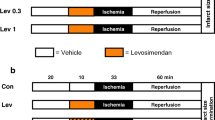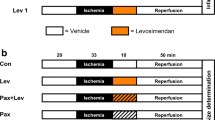Summary
The responses of the cardiac myocyte to a potentially injurious ischemic stress are multiple. The opening of the ATP-sensitive K+ channels may constitute one such response. These channels are present in the plasmalemma at very elevated density and have a large unitary conductance. Consequently, the opening of a small fraction (0.01–0.1%) of these channels during ischemia can help to drive the myocyte into an “emergency” state, in which its syncytial functions become rapidly downregulated and strategies appropriate to preserving cell viability are implemented. Thus, ATP-sensitive K+ channels in cardiac myocytes would appear to be an efficient and apparently redundant natural means of defense against metabolic stress. These channels can undergo physiologic modulation, as occurs during cardiac ischemic preconditioning in several species, including humans. The termcardioprotection refers to an endogenous cardioprotective strategy, whereby the myocardium slows its energy demands, produces fewer toxic glycolytic products, and exhibits reduced injury following a potentially lethal ischemic stress. Openers of cardiac ATP-sensitive K+ channels, a class of drugs that includes, in particular, aprikalim and nicorandil, also afford cardioprotection by reducing the functional and biochemical damage produced by ischemia. Hence, these compounds can improve the recovery of cardiac contractility, reduce the extracellular leakage of intracellular enzymes, delay the loss of ATP, and preserve the cell ultrastructure in isolated heart preparations subjected to transient ischemic conditions. Furthermore, when segmental contractility has been strongly depressed by a stunning insult, nicorandil and aprikalim can accelerate recovery at the reperfusion. Finally, nicorandil and aprikalim decrease substantially the size of the necrotic region that results from a prolonged ischemic insult followed by reperfusion. All of these desirable effects of K+-channel openers can be abolished by blockers of ATP-sensitive K+ channels, such as glibenclamide. The fundamental mechanism of the myocyte viability protection conferred by K+-channel openers is not yet clear. It may exploit some of the same pathways that mediate cardiac ischemic preconditioning. If this suggestion holds true, drugs opening cardiac ATP-sensitive K+ channels would mimic, exploit, or intensify those cardioprotective means that are naturally available to the cardiac myocyte for overcoming metabolic stress.
Similar content being viewed by others
References
Cavero I, Guillon JM. Pharmacological profile of potassium channel openers in the vasculature. In: Escande D, Standen N, eds.K + Channels in Cardiovascular Medicine. Paris: Springer-Verlag, 1993:193–223.
Hiraoka M, Fan Z. Activation of ATP-sensitive outward K+ current by nicorandil (2-nicotinamidoethyl nitrate) in isolated ventricular myocytes.J Pharmacol Exp Ther 1990;250:278–285.
Katz AM. Cardiac ion channels.N Engl J Med 1993;328:1244–1251.
Coetzee WA. ATP-sensitive potassium channels and myocardial ischemia: Why do they open?Cardiovasc Drugs Ther 1992;6:201–208.
Noma A, Matsuda H. The role of potassium channels in maintaining resting potential in normal and anoxic cardiac muscle. In: Escande D, Standen N, eds.K + Channels in Cardiovascular Medicine. Paris: Springer-Verlag, 1993:41–51.
Findlay I. Sulphonylurea drugs no longer inhibit the ATP-sensitive K+ channels during metabolic stress in cardiac muscle.J Pharmacol Exp Ther 1993;266:456–467.
Shattock MJ. Channel “selectivity” and evolution: Has evolutionary pressure and natural selection provided the ATP sensitive potassium channel in the myocardium as an endogenous protection against ischemic heart disease?Cardiovasc Res 1992;26:1153–1154.
Lynch JJ, Sanguinetti MC, Kimura S, et al. Therapeutic potential of modulating potassium currents in the diseased myocardium.FASEB J 1992;6:2951–2960.
Mullane K. Adenosine, ATP-sensitive K+ channels and myocardial preconditioning. In: Escande D, Standen N, eds.K + Channels in Cardiovascular Medicine. Paris: Springer-Verlag, 1993:273–283.
Yao Z, Gross GJ. A comparison of adenosine-induced cardioprotection and ischemic preconditioning in dogs. Efficacy, time-course and role of KATP channels.Circulation 1994;89:1229–1236.
Tombs CF, Morre TL, Shebuski RJ. Limitation of infarct size in the rabbit by ischaemic preconditioning is reversible with glibenclamide.Cardiovasc Res 1993;2:617–622.
Gross GJ, Auchampach JA. Blockade of ATP-sensitive potassium channels prevents myocardial preconditioning in dogs.Circ Res 1992;70:223–233.
Schulz R, Rose J, Heusch G. Involvement of activation of ATP-dependent potassium channels is involved in ischemic preconditioning in swine.Am J Physiol 1994;267:H1341-H1352.
Oian Y-Z, Levassur J, Yoshida K-I, et al. KATP channel in the rat heart: blockade of ischemic and acetylcholine-mediated preconditioning by glibenclamide.Am J Physiol 1995: in press.
Tomai F, Crea F, Gaspardone A, et al. Ischemic preconditioning during coronary angioplasty is prevented by glibenclamide, a selective ATP-sensitive K+ channel blocker.Circulation 1994;90:700–705.
Parrat J. Endogenous myocardial protective (antiarrhythmic) substances.Cardiovasc Res 1993;27:693–702.
Jennings RB, Murry CE, Reimer KA. Energy metabolism in preconditioned and control myocardium: Effects of total ischemia.J Mol Cell Cardiol 1991;33:1449–1458.
Meeting Report. The current status of stunning, hibernation and preconditioning. The impressions of a scientist: LH Opie.Cardiovasc Res 1993;27:886–888.
Escande D, Cavero I. Potassium channel openers in the heart. In: Escande D, Standen N, eds.K + Channels in Cardiovascular Medicine. Paris: Springer-Verlag, 1993:225–244.
Gross GJ, Auchampach JA. Role of ATP-dependent potassium channels in myocardial ischaemia.Cardiovasc Res 1992;26:1011–1016.
Grover GJ, McCullough JR, Henry DE, et al. Antiischemic effects of the potassium channel activators pinacidil and cromakalim and the reversal of these effects with the potassium channel blocker glyburide.J Pharmacol Exp Ther 1989;251:98–104.
Grover GJ, Newburger J, Sleph PG, et al. Cardioprotective effects of the potassium channel opener cromakalim: Stereo-selectivity and effects on myocardial adenine nucleotides.J Pharmacol Exp Ther 1991;257–162.
Grover GJ, Dzwonczyk S, Sleph PG. Reduction of ischemic damage in isolated rat hearts by the potassium channel opener RP 52891. Eur J Pharmacol 1990;191:11–19.
McPherson CD, Pierce GN, Cole WC. Ischemic cardioprotection by ATP-sensitive K+ channels involves high-energy phosphate preservation.Am J Physiol 1993;34:H1809-H1818.
Djellas Y, Mestre M, Cavero I. Aprikalim protection against ischemic injury occurs with an accelerated decrease in action potential duration but not in myocardial contractility.Circulation 1993;88:I632.
Auchampach JA, Maruyama M, Cavero I, et al. Pharmacological evidence for a role of ATP-dependent potassium channels in myocardial stunning.Circulation 1992;86:311–319.
Auchampach JA, Cavero I, Gross GJ. Nicorandil attenuates myocardial dysfunction associated with transient ischemia by opening ATP-dependent potassium channels.J Cardiovasc Pharmacol 1992;20:765–771.
Iwamoto T, Miura T, Urube K, et al. Effects of nicorandil on post-ischaemic contractile dysfunction in the heart: Roles of its ATP-sensitive K+ channel opening property and nitrate property.Clin Exp Pharmacol Physiol 1993;20:595–602.
Yao Z, Cavero I, Gross GJ. Activation of cardiac KATP channels: An endogenous protective mechanism during repetitive ischemia.Am J Physiol 1993;264:H495-H504.
Auchampach JA, Maruyama M, Cavero I, et al. The new K+ channel opener aprikalim (RP 52891) reduces experimental infarct size in dogs in the absence of hemodynamic changes.J Pharmacol Exp Ther 1991;259:961–967.
Schelling P, Becker KH, Lues I, et al. Cardioprotection by the K+ channel opener bimakalim in pigs under coronary artery occlusion and reperfusion.Eur Heart J 1992;13(Abstract Suppl:400).
Smallwood JK, Schelm JA, Bemis KG, et al. Effect of activation of ATP-dependent potassium channels with (-)-pinacidil and (-)-3-pyridyl pinacidil on infarct size in a canine model of ischemia-reperfusion injury.J Cardiovasc Pharmacol 1993;22:731–743.
Kitzen JM, McKallum JD, Harvey C. Potassium channel activators cromakalim and celikalim (WAY-120,491) fail to decrease myocardial infarct size in the anesthetised canine.Pharmacology 1992;45:71–82.
Yao Z, Gross GJ. Effects of the KATP channel opener bimakalim on coronary blood flow, monophasic action-potential duration and infarct size in dogs.Circulation 1994;89:1769–1775.
Escande D, Cavero I. K+ channel openers and “natural” cardioprotection.Trends Pharmacol Sci 1992;13:269–272.
Ovize M, Kloner RA, Hale SL, et al. Coronary cyclic flow variations “precondition” ischemic myocardium.Circulation 1992;85:779–789.
Cavero I, Premmereur J. ATP-sensitive potassium channel openers are of potential benefit in ischaemic heart disease.Cardiovasc Res 1994;28:32–33.
Prout TE, Knatterud GL, Meinert CL. The UGDP controversy. Clinical trials versus clinical impressions.Diabetes 1972;21:1035–1040.
Author information
Authors and Affiliations
Rights and permissions
About this article
Cite this article
Cavero, I., Djellas, Y. & Guillon, JM. Ischemic myocardial cell protection conferred by the opening of ATP-sensitive potassium channels. Cardiovasc Drug Ther 9 (Suppl 2), 245–255 (1995). https://doi.org/10.1007/BF00878472
Received:
Accepted:
Issue Date:
DOI: https://doi.org/10.1007/BF00878472




